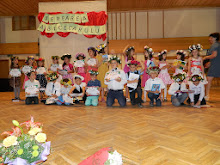Primary teacher Dorina Marin
“Dimitrie Anghel” School Cornesti –Miroslava - Iasi
Natural and cultural heritage education known at this time new dimensions. Through innovative approaches, it gives students a chance to learn the history and art, stimulating their interest and enthusiasm. Heritage is an invaluable tool for motivating students and help them to reconcile the past with valuable information with other from present and future and allows teachers to go beyond the boundaries of school subjects.
I have participated recently in a Comenius course about history and medieval art - A different view on Heritage Education - which gave me a different perspective about the teaching of history and art.
First I discovered that history can be translated into reality by moving through the vivid pictures, that any historical fact can be played through a meaningful symbol, with expressive body movements, no gestures of pantomime, just an externalization of feelings which that event stirs in our minds.
First I discovered that history can be translated into reality by moving through the vivid pictures, that any historical fact can be played through a meaningful symbol, with expressive body movements, no gestures of pantomime, just an externalization of feelings which that event stirs in our minds.
Second I learned, through an expert how to deciphering the meanings of the Romanesque style, that the world in which our ancestors lived is not so different from ours and they tied with fantasy elements of the real Bible, recounting myths and biblical stories.
These lessons were genuine European pedagogy blended with the practical activities to the challenges new teachers and museology, people thirst for knowledge, open to novelty, and our active participation involved in this kind of activity.
Did you know that teachers are the best students?
We, participants in this course, we was living proof that shows that these innovative methods can be implemented successfully. We lived the life of a tree in a minute, from seed, and until it becomes ashes, we understand what it means to share, to be generous, to pass on a piece of history by body movements and inflections of voice, while we have implemented in various places, w understand the history of thought and heart and we passed the information to colleagues, by team activities, overcoming language and cultural barriers, as though we have always been colleagues and friends.
Based on the explanations of the guide, we then made our own conections between small statue is adorned with a church and the surrounding reality, we choose some items and we have played through drawings and e we have found correspondenc in real life with puzzles.
The link between past, present and future was emphasized in the photographic and culinary arts. We learned how an image can become art if it is viewed and played from different points of view and how important are the details or rather combining elements: new symbols found on ancient buildings and old architecture surrounded by new elements.
Musée des Arts de Cognac was another unusual location for a practice session work, which was filled with notions about the history of its production from Remy Martin.
And modern art from Pascal Mirande which stimulated us to achieve small pieces of land art have completed a course on modern painting, challenging and nonconformist ways.
It is worth noting that both, trainers and course organizers, from Go! Onderwijs van de Vlaamse Gemeenschap - Belgium have always brought out the history and how art can now be integrated, because it is part of our daily life, because future generations deserve treasured and passed through various, interactive, modern ways. The location of the course, the former royal Abbey which now operate as the European Cultural Centre and the surrounding monuments are very good examples of how both past and present was recovered by residents, special people who have organized for us, even a medieval banquet to introduce us in a wonderful atmosphere in which to run, with hundreds of years ago, a priceless moment of history.

